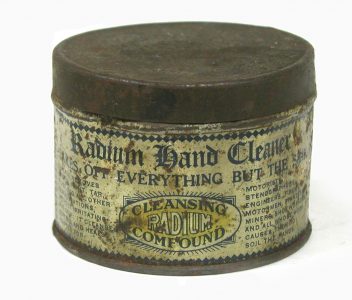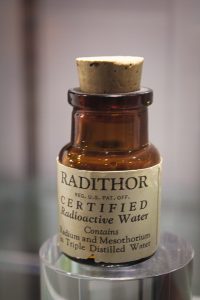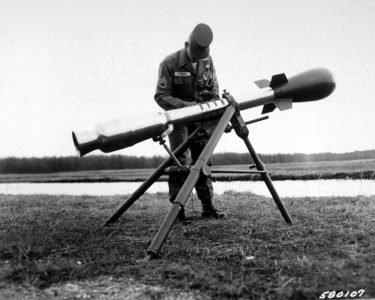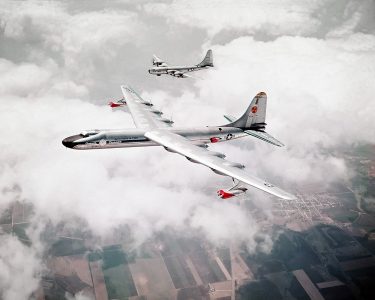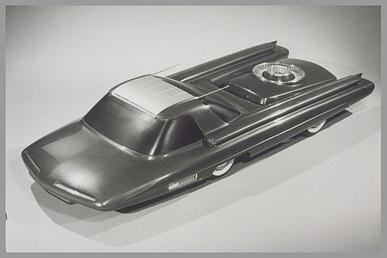- When has something being lethally dangerous ever stopped people from trying to use it for everything?
Since the discovery of radioactivity in 1896, we’ve put the phenomenon to more or less good use. Today, we use nuclear power to produce energy, unleash immense destruction with atom bombs — and ironically treat cancer.
But before this, people made some rather… Questionable nuclear-powered and radioactive inventions. Granted, they were still trying to figure out what the heck it even was.
Here are seven of the most bizarre radioactive or nuclear-fueled things ever made.
8) Radium Hand Cleaner
The 1930s was a weird time. You could find household goods, beauty products, and medications with the most outlandish additives — like radium.
Joining that crowd was the Radium Hand Cleaner, produced by Radium Compound Company in Phoenix, New York. The stuff was produced around 1910-1920.
The manufacturer, naturally, claimed that the hand cleaner was much more effective than non-radioactive products. It was reportedly marketed with the slogan, “It takes everything off but the skin!”
Use it enough, though, and we’re pretty sure you can kiss your skin goodbye as well.
7) Radithor
Another bizarre product from the early 1900s is Radithor. This patent medicine relied on the theory of radioactive hormesis, claiming small amounts of ionizing radiation are good for us.
As such, the medicine consisted of triple-distilled water and 1 microcurie each of radium 226 and 228. And what was it supposed to cure?
Pretty much everything. The quack “doctor” marketing the stuff claimed it worked for anything from rheumatism to impotence and — ironically — stomach cancer.
Radithor even had a powerful supporter. Socialite and industrialist Eben Beyers supported the “medicine” and reportedly drank 1,400 bottles of it over his life.
Beyers mysteriously died from multiple radiation-induced types of cancer in 1932. His body was so irradiated that his skull began to fall apart and when his lead-lined coffin was exhumed in 1965, his bones were still extremely radioactive.
6) Radioactive Golf Balls
What do you do if you lose your ball on a golf course? According to Dr. William L. Davidson, you just break out a Geiger counter.
Dr. Davidson developed a golf ball containing 1/50th of a gram of “radioactive materials.” His reasoning was that golfers could always find lost balls with a Geiger counter and a pair of headphones.
The problem was that the balls weren’t radioactive enough. You already had to stand practically next to the ball for the counter to register it.
Also, what if there were 50 lost radioactive golf balls lying around? And what if nobody ever removed them from the field?
5) Radioactive Erectile Supports
Today, if you need to kick-start the little fella in your pants, you just pop a Viagra. But in the first half of the 1900s, you’d rely on something much more uncomfortable.
Allow us to introduce you to radioactive bougies. Basically, they were thin, radioactive wax rods you’d stick up your urethra.
That was supposed to give you an erection that’d last for a steamy, sexy night. Yeah, the people back then were into some weird s***.
Then there was the Radioendocrinator. It was basically a stack of small, radium-laden cards you were supposed to put in your underwear overnight.
The cards’ purpose was to enhance male virility. On a completely unrelated note, their inventor died of bladder cancer in 1949.
4) M-29 Davy Crockett
After the invention of the atomic bomb, militaries around the world started a nuclear arms race. In the U.S., that resulted in the 1961 unveiling of the M-28 Davy Crockett.
The thing is a recoilless rifle — basically a bazooka — armed with a 51-pound nuclear warhead. The gun could lob the mini-nuke at a target up to three miles away.
But here’s the thing — three miles isn’t far enough. If anybody ever fired the gun, they’d also get caught in the fallout.
And if the wind happened to blow in the wrong direction, the radiation would get pushed back into your lines. Unsurprisingly (or, honestly, surprisingly) Davy Crockett was never used in real combat.
3) Convair NB-36H
The U.S. military wasn’t satisfied with a nuclear bazooka. They still wanted to drop full-sized nukes, but airplanes couldn’t carry them very far at the time.
So why not build a nuclear plane to carry the nuclear bomb? This idea gave us the Convair NB-36H “Crusader,” a nuclear-powered bomber with a theoretically infinite operational range.
The plane’s cockpit was covered in radiation shielding to protect the pilots. The reactor itself was also immersed in a large water tank to capture escaping radiation.
But then somebody asked, “What if this plane crashes?” That question and further advancements in conventional airplane tech made the Crusader unnecessary.
Nonetheless, the plane did get built and racked up 215 hours of flight time — 89 of which were nuclear-propelled.
2) Ford Nucleon
But forget about airplanes — how about a nuclear-powered car? In 1957, a designer at Ford had that thought and it resulted in the Ford Nucleon concept vehicle.
Instead of a combustion engine, the Nucleon had a small nuclear reactor housed in its trunk. The thing worked like a modern nuclear submarine, using uranium fission to transform water into steam power.
But then somebody asked, “What if this car crashes?” That question and the inability to build a small enough reactor meant the Nucleon only ever became a miniature scale model.
And that’s probably for the best.
1) LENR
We’ve already tried powering so many things with nuclear reactors. We might as well add a nuclear reactor to our houses at this point.
Wait, they’re working on that?
Indeed, this is Low-Energy Nuclear Reactor or LENR. Developed by Chicago entrepreneur Lewis Larsen, it’s about as small as a microwave can could power a house with “almost no” emissions.
That sounds so comforting.
But the thing is, this is the harebrained idea of a rogue inventor. NASA is currently funding research into LENRs, hoping they’ll one day power houses and spacecraft.
Because a functional nuclear reactor is exactly what the average Joe should have in his home.
Hits: 0

